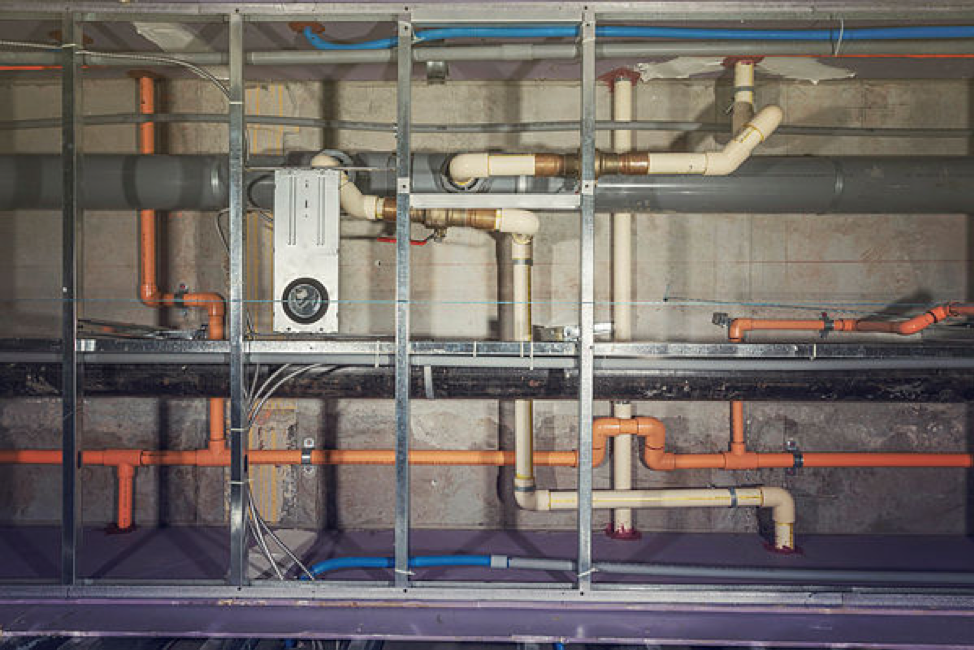How Can CPVC Create a Reliable Fire Protection System?
Chlorinated Polyvinyl Chloride (CPVC) is a specially engineered thermoplastic first commercialized by Lubrizol in the early 1960’s. Since its first use, CPVC has steadily grown in popularity and is now used in industrial, commercial and residential buildings around the world.
However, a thermoplastic may not be the first thing that comes to mind when discussing fire protection systems. So, what makes CPVC a viable piping material for fire sprinkler systems?
A breakdown of the science of CPVC may help explain it.
Molecular Makeup
CPVC is unlike other plastics. Many plastics such as PEX and polypropylene consist entirely of hydrocarbons, an excellent fuel. This is why some plastics, when exposed to a flame, will continue to burn long after the flame is removed. Eventually, these plastics melt and cause flaming drips to fall from them.
CPVC consists of more than 65% chlorine, a natural fire retardant. The high level of chlorine also provides pressure-bearing capability at high temperatures and excellent corrosion resistance.
This is the primary difference between CPVC and PVC. PVC consists of only 57% chlorine, limiting its pressure performance at high temperatures.
Flame Resistance Qualities of CPVC
When exposed to a flame, the chlorine in CPVC acts as a flame retardant, preventing the material from burning unless it is continuously held inside the flames. The material self-extinguishes as soon as the flame is removed. In addition, CPVC’s molecular structure and morphology cause it to form a thick insulative char layer on the exterior, protecting the rest of the pipe from additional damage. This gives CPVC qualities that allow for the reliable delivery of water, even when engulfed in flame.
- High Flash Ignition Temperature: BlazeMaster® CPVC has a flash ignition temperature—the lowest temperature at which CPVC can support combustion—of 900°F (482°C).
- High Limiting Oxygen Index (LOI): BlazeMaster CPVC requires 60% oxygen in the surrounding atmosphere to sustain a flame. For reference, Earth’s atmosphere is made up of only 21% oxygen. This means that when a source of flame is removed, CPVC self extinguishes.
- Limited smoke generation: When exposed to a flame, BlazeMaster CPVC will limit the amount of smoke produced, potentially cutting down on smoke damage compared to another material.
- Charring: The exterior of BlazeMaster CPVC piping chars rather than melts when exposed to a flame up to a certain temperature. This charred surface helps to insulate the interior of the piping, maintaining its structural integrity.
Corrosion-Resistant Qualities of CPVC
CPVC also has excellent corrosion resistance, both inside and out. It can be installed in corrosive environments, such as pool and spa areas, or areas exposed to salty ocean air without concern for exterior corrosion.
It is also resistant to microbially induced corrosion (MIC), which often occurs in stagnant systems such as fire sprinklers. MIC can cause reduced waterways inside metal piping due to corrosion product buildup, as well as pinhole leaks.
BlazeMaster CPVC’s corrosion resistance helps to:
- Maintain the smooth piping surface. BlazeMaster CPVC has a Hazen-Williams C-Factor (the measure of surface smoothness) of 150, compared to steel’s 120, which can drop to 60 over the course of its life.
- Keep the piping free of debris that can break away from a pipe’s surface and potentially clog or restrict the flow of water through a sprinkler head.
- Retain the system’s structural integrity, avoiding weak spots in the piping or joints that may burst under pressure or start to leak.
BlazeMaster® CPVC is Scientifically Engineered for Fire Protection
BlazeMaster fire protection systems have invested significant time and resources into optimizing its CPVC. In doing so, they’ve created a cost-effective alternative to steel that is more reliable, lasts longer, and is better for the environment.
BlazeMaster CPVC is also verified by major international agencies. You can see a list of BlazeMaster system listings and approvals here.
Interested in learning more about BlazeMaster CPVC and how it can help with your fire protection needs? Schedule a free consultation with our team of piping systems consultants.


